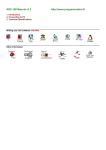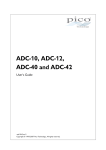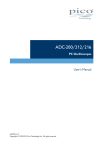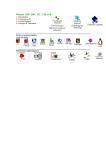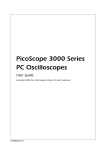Download ADC 100 User`s guide
Transcript
ADC-100 PC Oscilloscope User's Guide adc100.en-2 © Copyright 2004-2007 Pico Technology Limited. All rights reserved. I ADC-100 User's Guide Contents 1 Introduction .....................................................................................................................................1 ...........................................................................................................................................1 1 Overview ...........................................................................................................................................1 2 Installing the driver ...........................................................................................................................................1 3 Connecting to the PC ...........................................................................................................................................2 4 Software configuration 5 Safety...........................................................................................................................................2 warning ...........................................................................................................................................3 6 Legal information ...........................................................................................................................................4 7 Company details 2 Product information .....................................................................................................................................5 ...........................................................................................................................................5 1 Specifications 2 Scaling...........................................................................................................................................5 ...........................................................................................................................................5 3 Streaming 3 Technical reference .....................................................................................................................................7 ...........................................................................................................................................7 1 Introduction ...........................................................................................................................................8 2 Windows 3 Driver...........................................................................................................................................9 routines ...........................................................................................................................................9 1 adc100_get_driver_version ...........................................................................................................................................9 2 adc100_open_unit ...........................................................................................................................................9 3 adc100_close_unit ...........................................................................................................................................10 4 adc100_set_unit ...........................................................................................................................................10 5 adc100_set_range ...........................................................................................................................................11 6 adc100_get_value ...........................................................................................................................................11 7 adc100_is_streaming ...........................................................................................................................................11 8 adc100_run ...........................................................................................................................................12 9 adc100_ready ...........................................................................................................................................12 10 adc100_stop ...........................................................................................................................................13 11 adc100_set_trigger ...........................................................................................................................................14 12 adc100_set_interval ...........................................................................................................................................15 13 adc100_get_values ...........................................................................................................................................16 14 adc100_get_times_and_values ...........................................................................................................................................16 15 adc100_get_unit_info ...........................................................................................................................................17 16 adc100_get_combined_values ...........................................................................................................................................17 17 adc100_apply_fix ...........................................................................................................................................18 4 Programming 1 C / C++...........................................................................................................................................18 2 Delphi ...........................................................................................................................................18 3 Excel ...........................................................................................................................................19 ...........................................................................................................................................19 4 LabVIEW ...........................................................................................................................................19 5 Visual Basic 6 Agilent...........................................................................................................................................19 VEE 7 Linux ...........................................................................................................................................19 Index ..............................................................................................................................................21 adc100.en © Copyright 2004-2007 Pico Technology Limited. All rights reserved. Introduction 1 Introduction 1.1 Overview 1 The Pico ADC-100 and ADC-101 are medium-speed analog-to-digital converters with two analog input channels and programmable input voltage ranges. They can be used as a virtual instrument (oscilloscope, spectrum analyser and meter) with the PicoScope program, or as a data logger using PicoLog. Alternatively, you can use the ADC-100 driver software to develop your own programs to collect and analyse data from the unit. This manual describes the physical and electrical properties of the ADC-100 and ADC-101, and explains how to use the Windows software drivers. For information about the software supplied with the unit, please refer to the help files and PDFs. 1.2 Installing the driver You may choose to install the driver when you install the PicoScope or PicoLog software. Alternatively, you can download the driver from our website at www.picotech.com. 1.3 Connecting to the PC The ADC-100 and ADC-101 can be connected to the PC in two ways: Directly to a printer port on the computer To a USB port on the computer, via a Pico USB parallel port adapter. Printer port operation When you install the application software from the Pico CD, the computer will ask you which port to use. You should select LPT1, LPT2 or LPT3. To use the ADC, you should connect it to the printer port on your computer, either directly or using a good quality extension cable. USB port operation Please note that USB printer port interfaces are not suitable for use with Pico products. If you wish to connect a Pico product to a USB port, you will need a Pico USB Parallel Port adapter. You will also need Windows 98, ME, 2000 or XP. When you install the application software from the Pico CD and the computer asks you which port to use, you should select USB-PP1 Once the USB driver software is installed, connect the Pico USB parallel port adapter to your PC and the computer will automatically configure the drivers. See streaming for more information about the advantages of operating via a Pico USB parallel port. © Copyright 2004-2007 Pico Technology Limited. All rights reserved. adc100.en 2 1.4 ADC-100 User's Guide Software configuration Checking the installation To check that the unit is working, start up the PicoScope program and then connect a voltage source to the BNC connector. The ADC has the same connectors as an oscilloscope, so you can use standard oscilloscope probes. PicoScope should now display the voltage that you have connected. If you are using scope probes, when you touch the scope probe tip with your finger, you should see a small 50 Hz or 60 Hz signal on the screen. If you have connected the ADC to a printer port other than the port specified when you installed the software, you will need to go to the Setup panel and then change the port number to the appropriate value (USB port numbers begin with USB-PPx. If you have more than one USB parallel port, they will be numbered according to the order they are plugged into the PC). You will need to exit and re-enter the software to activate the change. 1.5 Safety warning We strongly recommend that you read the general safety information below before using your product for the first time. If the equipment is not used in the manner specified, then the protection provided may be impaired. This could result in damage to your computer and/or injury to yourself or others. Maximum input range The ADC-100 is designed to measure voltages in the range of -20V to +20V. Any voltages in excess of ±100V may cause permanent damage to a unit. Mains voltages Pico products are not designed for use with mains voltages. To measure mains we recommend the use of a differential isolating probe specifically designed for such measurements. Safety grounding The ground of every product is connected directly to the ground of your computer via the interconnecting cable provided. This is done to minimise interference. If the PC (especially laptops) is not grounded, reading stability cannot be guaranteed and it may be necessary to manually ground the equipment. As with most oscilloscopes and data loggers, you should take care to avoid connecting the inputs of the product to any equipment which may be at an unsuitable voltage. If in doubt, use a meter to check that there is no hazardous AC or DC voltage. Failure to check may cause damage to the product and/or computer and could cause injury to yourself or others. Take great care when measuring temperatures near mains equipment. If a sensor is accidentally connected to mains voltages, you risk damage to the converter or your computer and your computer chassis may become live. You should assume that the product does not have a protective safety earth. Incorrect configuration and/or use on voltages outside the maximum input range can be hazardous. adc100.en © Copyright 2004-2007 Pico Technology Limited. All rights reserved. Introduction 3 Repairs The unit contains no user-serviceable parts: repair or calibration of the unit requires specialised test equipment and must be performed by Pico Technology Limited or their authorised distributors. 1.6 Legal information The material contained in this release is licensed, not sold. Pico Technology Limited grants a license to the person who installs this software, subject to the conditions listed below. Access The licensee agrees to allow access to this software only to persons who have been informed of these conditions and agree to abide by them. Usage The software in this release is for use only with Pico products or with data collected using Pico products. Copyright Pico Technology Limited claims the copyright of, and retains the rights to, all material (software, documents etc.) contained in this release. You may copy and distribute the entire release in its original state, but must not copy individual items within the release other than for backup purposes. Liability Pico Technology and its agents shall not be liable for any loss, damage or injury, howsoever caused, related to the use of Pico Technology equipment or software, unless excluded by statute. Fitness for purpose No two applications are the same: Pico Technology cannot guarantee that its equipment or software is suitable for a given application. It is your responsibility, therefore, to ensure that the product is suitable for your application. Mission critical applications This software is intended for use on a computer that may be running other software products. For this reason, one of the conditions of the license is that it excludes usage in mission critical applications, for example life support systems. Viruses This software was continuously monitored for viruses during production, however you are responsible for virus-checking the software once it is installed. Support If you are unsatisfied with the performance of this software, please contact our technical support staff, who will try to fix the problem within a reasonable time scale. If you are still unsatisfied, please return the product and software to your supplier within 28 days of purchase for a full refund. Upgrades We provide upgrades, free of charge, from our web site. We reserve the right to charge for updates or replacements sent out on physical media. © Copyright 2004-2007 Pico Technology Limited. All rights reserved. adc100.en 4 ADC-100 User's Guide Trademarks Pico Technology Limited, PicoScope, PicoLog, DrDAQ and EnviroMon are trademarks of Pico Technology Limited, registered in the United Kingdom and other countries. Pico Technology acknowledges the following product names as trademarks of their respective owners: Windows, Excel, Visual Basic, LabVIEW, Agilent VEE, HP VEE, Delphi. 1.7 Company details Address: Pico Technology Limited The Mill House Cambridge Street St Neots Cambridgeshire PE19 1QB United Kingdom Phone: +44 (0)1480 396395 Fax: +44 (0)1480 396296 Email: Technical Support [email protected] Sales [email protected] Web site: www.picotech.com adc100.en © Copyright 2004-2007 Pico Technology Limited. All rights reserved. Product information 2 Product information 2.1 Specifications ADC-100 Resolution Channels Voltage ranges Overload protection Input impedance ADC-101 12 bits 2 x BNC ±50 mV to ±20 V in 9 ±100 mV to ±100 V in 9 ranges ranges ±100 V 1 MW Input type Maximum sampling rate Linearity Accuracy Scope timebases Spectrum ranges Analog bandwidth Buffer size Power supply Dimensions Output connector 2.2 5 single-ended differential 40 kS/s ±4 LSB at 25 C ±2% 100 us/div to 50s/div 0 to 50 kHz, 70 dB dynamic range 50 kHz No buffer None required 85 x 145 x 25mm 25-way male D-type to PC parallel port Scaling The ADC-100 and ADC-101 are 12-bit analog to digital converters. This means that they produce values in the range 0 to 4095 to represent the currently selected input voltage range. To convert from ADC readings to volts, you should subtract half of the 2048, multiply by the currently selected voltage range and divide by 2048. Thus, on the 5 V range, an ADC reading of 3135 represents (3135-2048) x 5 / 2048 = 2.654 volts. 2.3 Streaming If a device is connected to a Pico USB parallel port, data is collected in an asynchronous manner, without any intervention from the PC. This gives considerably more reliable data collection, and sampling does not interfere with the operation of the your computer. When collecting data from a streaming device using the drivers, three modes are available: BM_SINGLE Collect a single block of data and exit BM_WINDOW Collect a series of overlapping blocks of data BM_STREAM Collect a continuous stream of data. © Copyright 2004-2007 Pico Technology Limited. All rights reserved. adc100.en 6 ADC-100 User's Guide BM_SINGLE is useful when you wish to collect data at high speed for a relatively short period. For example, to collect 1000 readings in 50 ms. BM_WINDOW is useful when collecting several blocks of data at relatively low speeds- for example when collecting 10000 samples over 10 seconds. Collecting a sequence of SINGLE blocks like this would take 10 seconds for each block, so displayed data would not be updated frequently. Using windowing, it is possible to ask for a new block more frequently, for example every second, and to receive a block containing nine seconds of data that have already been seen and one second of new data. The block is effectively a 10-second 'window' that advances one second each time. BM_STREAM is useful when you need to collect data continuously for long periods. In principle, it would be possible to collect data indefinitely. Each time adc100_get_values is called, it returns the new readings since the last time it was called. No_of_values passed to adc100_run must be sufficient to ensure that the buffer does not overflow between successive calls to adc100_get_values. For example, if you call adc100_get_values every second, and you are collecting 500 samples per second, no_of_values must be at least 500, and preferably 1000 to give some allowance for delays in the operating system. adc100.en © Copyright 2004-2007 Pico Technology Limited. All rights reserved. Technical reference 3 Technical reference 3.1 Introduction 7 The ADC-100 and ADC-101 are supplied with driver routines that you can build into your own programs. Once you have installed the software, the DRIVERS sub-directory contains the drivers and a selection of examples of how to use the drivers. It also contains a copy of this help file in text format. The driver routines are supplied as Dynamic Link Libraries for Windows 95/98/ME and NT/200/XP. The Windows DLLs can be used with any programming language or application that can interface with DLLs- for example, C, Delphi, Visual Basic, Excel, LabVIEW, etc. The DRIVERS directory contains example programs for several popular programming languages or applications: some of these examples are fairly simple, but the C console mode example, a100con.c, shows how to use all facilities in the driver. The driver is capable of supporting up to three units connected to printer ports (one each on LPT1, LPT2 and LPT3) and up to four Pico USB parallel port units. The units can be any mixture of ADC-100 and ADC-101. The following table explains each of the driver routines. Routine adc100_get_driver_version adc100_open_unit adc100_set_unit adc100_close_unit adc100_set_range adc100_get_value adc100_is_streaming adc100_run adc100_ready adc100_stop adc100_set_trigger adc100_set_interval Description that this is the correct driver the driver to use a specified parallel port which ADC-100 unit to use the specified port input voltage range single reading from one channel whether the device supports streaming (USB only) the unit recording whether the data recording is completed data collection a trigger event from a specified channel channels and time interval for the next call to adc100_get_values, or adc100_get_times_and_values adc100_get_values block of readings at fixed intervals adc100_get_times_and_values a block of readings and their times, at fixed intervals adc100_get_unit_info information about an ADC-100 unit The driver offers the following facilities: Specify the printer port that is connected to the ADC-100 Take a single reading from a specified channel Specify a trigger event from a specified channel (only available in block mode) Collect a block of samples at fixed time intervals from one or more channels © Copyright 2004-2007 Pico Technology Limited. All rights reserved. adc100.en 8 ADC-100 User's Guide Under Windows, if you connect the product to the computer via a Pico USB parallel port, timing is completely reliable. However, if you connect the product to the computer via the printer port, the sampling may be affected by Windows activities. At the least, there will be gaps in the data every 55 milliseconds due to the Windows timer function. There will be additional gaps if you move the mouse, or have other programs running. We therefore recommend using the adc100_get_values_and_times routine, so that you can determine the exact time that each reading was taken. The normal calling sequence to collect a block of data is as follows: 1. 2. 3. 4. 5. 6. 7. 8. 9. 10. 11. 12. 3.2 Check that the driver version is correct Open the driver Set trigger mode (if required) Set sampling mode (channels and time per sample) While you want to take measurements, Run While not ready Wait End while Get a block of data End While Close the driver Windows The Windows XP/Vista driver, PICO.SYS, is installed in Windows. The operating system must be told that the driver is available: this is normally done automatically by the setup program, but can also be done manually using the the regdrive.exe program which is copied into the Pico directory. Type: regdrive pico The Windows XP/Vista USB port driver, PICOPP.SYS, is installed in the Windows system directory. The file picopp.inf must be placed there so that Windows knows which driver to load when the USB parallel port is plugged in. The Windows driver is accessed using the file ADC10032.DLL, which is installed in drivers\. The DLL uses STDCALL linkage conventions, and undecorated names. The same ADC10032.dll file can be used for both parallel port and USB port-connected products. adc100.en © Copyright 2004-2007 Pico Technology Limited. All rights reserved. Technical reference 3.3 Driver routines 3.3.1 adc100_get_driver_version 9 PREF1 short PREF2 adc100_get_driver_version (void); This routine returns the version number of the ADC100/101 driver. You can use it to check that your application is used only with the driver version that it was designed for use with. Generally speaking, new driver versions will be fully backward compatible with earlier versions, though the converse is not always true, so it should be safe to check that the driver version is greater than or equal to the version that it was designed for use with. The version is a two-byte value, of which the upper byte is the major version and the lower byte is the minor version. Arguments: Returns: 3.3.2 adc100_open_unit PREF1 short PREF2 adc100_open_unit ( short port); This routine opens the ADC-100 driver. With the Windows 32-bit driver, the routine assumes that the printer ports 1..3 are at 0x378, 0x278 and 0x3BC. It then calibrates the timing functions for the computer. It returns TRUE if successful. If it is not successful, you can call adc100_get_unit_info to find out why it failed. 3.3.3 Arguments: port - the number of the parallel or USB port to which the ADC-100 is connected: 1 - LPT1 2 - LPT2 etc 101 - USB-PP1 102 - USB-PP2 etc Returns: TRUE if successful adc100_close_unit PREF 1 short PREF2 adc100_close_unit ( short port); This routine closes the ADC-100 driver. Arguments: port - the number identifying the port Returns: © Copyright 2004-2007 Pico Technology Limited. All rights reserved. adc100.en 10 3.3.4 ADC-100 User's Guide adc100_set_unit PREF1 short PREF2 adc100_set_unit ( short port); This routine is used to select the unit to use for subsequent operations. It is only necessary to use this function if you wish to have more than one unit open at the same time. Arguments: Returns: 3.3.5 adc100_set_range PREF 1 void PREF2 adc100_set_range ( short mv_a, short mv_b); This routine sets the range for both channels. The two parameters are two index entries in a lookup table (below), representing the input range for channels A and B. The ADC-100 is bipolar, so 20,000 means that the input voltage range is 20 V. Note: For the ADC-101, the actual voltage range is always five times the voltage range specified. Thus, if mv_a is set to 20000, the actual voltage range is 100,000 mV, or 100V. The values in the following table will give the expected result: intermediate values will be rounded to the nearest above. Location in index Voltage range (ADC-100) Voltage range (ADC-101) V V V V V mV mV mV mV V V V V V mV mV mV mV 20000 10000 5000 2000 1000 500 200 100 50 If you are not using a channel, we recommend setting the range to 20 V. This prevents noise from the unconnected channel interfering with the channel that you are using. Arguments: mv_a mv_b Returns: adc100.en none © Copyright 2004-2007 Pico Technology Limited. All rights reserved. Technical reference 3.3.6 11 adc100_get_value PREF 1 short PREF2 adc100_get_value ( short channel); This routine reads the current value of one channel. Depending on your computer, it will take approx 20µs to take one reading. Arguments: channel 0 - channel A 1 - channel B Returns: 3.3.7 adc100_is_streaming short adc100_is_streaming (void) This routine can be used to determine whether the device is capable of supporting streaming. If so, it will return TRUE (1). A streaming device collects data in an asynchronous manner. USB devices generally support streaming, whereas parallel port devices do not. Arguments: none Returns: 3.3.8 TRUE if the device supports streaming adc100_run void adc100_run ( unsigned long no_of_values, unsigned short method) This routine starts a streaming unit collecting data It collects readings at intervals and from channels specified in the most recent adc100_set_interval call. For non-streaming devices, this function has no effect. Arguments: no_of_values - the number of samples that are to be collected method - the data collection method: BM_SINGLE (0) - collect a single block and stop BM_WINDOW (1) - collect a sequence of overlapping blocks BM_STREAM (2) - collect a continuous stream of data Returns: © Copyright 2004-2007 Pico Technology Limited. All rights reserved. adc100.en 12 3.3.9 ADC-100 User's Guide adc100_ready short adc100_ready (void) This routine indicates whether a streaming device has completed its data collection. Arguments: none Returns: - TRUE if the device is ready to transfer data. For non-streaming devices, it always return TRUE 3.3.10 adc100_stop void adc100_stop (void) This function cancels any pending request for data from a streaming device. It has no effect for non-streaming devices. Arguments: none Returns: adc100.en none © Copyright 2004-2007 Pico Technology Limited. All rights reserved. Technical reference 13 3.3.11 adc100_set_trigger PREF1 void unsigned unsigned unsigned unsigned unsigned unsigned unsigned PREF2 short short short short short short short adc100_set_trigger ( enabled, auto_trigger, auto_ms, channel, dir, threshold, delay); This routine defines a trigger event for the next block operation, and specifies the delay between the trigger event and the start of collecting the data block. Note that the delay can be negative for pre-trigger. If the computer is stuck waiting for a trigger that never occurs, you can abort the data collection by pressing the F10 key. Arguments: enabled - this is TRUE if the ADC-100 is to wait for a trigger event, and FALSE if the ADC-100 is to start collecting data auto_trigger - this is TRUE if the ADC-100 is to trigger after a specified time (even if no trigger event occurs). This prevents the computer from locking up, if no trigger event occurs auto_ms specifies the time in ms after which auto_trigger will occur channel specifies which channel is to be used as the trigger input: 0 - channel A 1 - channel B dir the direction can be rising or falling threshold delay Returns: - this is the threshold at which a trigger event on channel A or B takes place. It is scaled in ADC counts - This specifies the delay between the trigger event and the start of the block,as a percentage of the block size. Thus, 0% means the first data value in the block, and -50% means that the trigger event is in the middle of the block none © Copyright 2004-2007 Pico Technology Limited. All rights reserved. adc100.en 14 ADC-100 User's Guide 3.3.12 adc100_set_interval PREF1 unsigned long PREF2 adc100_set_interval ( unsigned long us_for_block, unsigned long ideal_no_of_samples, short mode); This routine specifies the time interval per sample and the channels to be used for calls to adc100_get_values or adc100_get_times_and_values. An example of a call to this routine using both channels A and B is: adc100_set_interval (10000, 100, 2); The routine returns the actual time to collect this number of samples. This actual time may be greater than the target time if you specified a sampling interval that is faster than your computer can manage. If the specified sampling rate was too fast, you have the following choices: If the total time is important, collect fewer than the ideal number of samples so that the total block time is correct If the number of samples is important, collect the same number of samples then allow for the fact that they took longer to collect. Arguments: us_for_block - target total time in which to collect ideal_no_of samples, in microseconds ideal_no_of_samples - specifies the number of samples that you intend to collect. This number is only used for timing calculations: you can actually collect a different number of samples when you call adc100_get_values mode 0 - channel A only 1 - channel B only 2 - both channels no_of_channels - specifies the number of channels to be used Returns: adc100.en © Copyright 2004-2007 Pico Technology Limited. All rights reserved. Technical reference 15 3.3.13 adc100_get_values PREF 1 unsigned long PREF2 adc100_get_values ( unsigned short HUGE * buffer_a, unsigned short HUGE * buffer_b, unsigned long no_of_values); This routine reads in a block of values. It collects readings at intervals and from channels specified in the most recent adc100_set_interval call. If a key is pressed while collecting, the routine will return immediately. The return value will be zero if a key was pressed, and the total time in micro-seconds if a block was successfully collected. When collecting data from just one channel, the parameter for the other buffer can either be set to NULL, or pointed at the same buffer. Arguments: buffer_a buffer_b no_of_values Returns: © Copyright 2004-2007 Pico Technology Limited. All rights reserved. adc100.en 16 ADC-100 User's Guide 3.3.14 adc100_get_times_and_values PREF1 unsigned long PREF2 adc100_get_times_and_values ( long HUGE * times, unsigned short HUGE * buffer_a, unsigned short HUGE * buffer_b, unsigned long no_of_values); This routine reads a block of values from the unit in the most recent adc100_open_unit or adc100_set_unit call. It takes readings at nominal intervals specified in the most recent adc100_set_interval call, and returns the actual times for each reading. If a key is pressed while collecting, the routine will return immediately. The return value will be zero if a key was pressed, and the total in micro-seconds if a block was successfully collected. When collecting data from just one channel, the parameter for the other buffer can either be set to NULL, or pointed at the same buffer. Arguments: times buffer_a buffer_b no_of_values Returns: 3.3.15 adc100_get_unit_info PREF1 short PREF2 adc100_get_unit_info ( char * str, short str_lth, short line, short port); If the specified unit failed to open, this routine returns a text string which explains why the unit was not opened. If the specified unit is open, The routine returns version information about the ADC-100 DLL, the Windows driver and the sampling rate. Arguments: str - character string buffer for result str_lth - length of buffer line - 0 to 3: selects which line to return port - the printer port number (1..3) to return information for Returns: adc100.en © Copyright 2004-2007 Pico Technology Limited. All rights reserved. Technical reference 17 3.3.16 adc100_get_combined_values PREF1 unsigned long PREF2 adc100_get_combined_values ( UNS16 channel, COMBINATION_METHOD mode, /* Combination modes (CM_XXX) */ UNS16 no_of_readings ) This routine takes a set of readings from the specified channel, at full speed, and returns either the minimum, maximum, average or sum of the set of readings. Arguments: channel 0 - channel A 1 - channel B mode 0 - average 1 - minimum 2 - maximum 3 - sum no_of_readings - the number of readings to take Returns: 3.3.17 adc100_apply_fix PREF1 void PREF2 adc100_apply_fix ( unsigned int fix, unsigned int value ) Some PCs have non-Centronics-compliant parallel ports. The ADC-100 requires a small grey adapter (supplied with the unit) between the ADC-100 and the parallel cable. This driver usually auto-detects the adapter, but occasionally you will need to use this function to force the adapter into being used. Arguments: fix value Returns: - adapter detect 0 - auto-detect adapter 1 - force no adapter 2 - force use of adapter none Note: An alternative to using this routine is to add an entry to the win.ini file (usually located in C:\WINDOWS\), add the following lines: [ADC100] UseAdapter=Yes UseAdapter can be Yes, No or Auto (Auto is the default if these lines are not present in the win.ini file) © Copyright 2004-2007 Pico Technology Limited. All rights reserved. adc100.en 18 ADC-100 User's Guide 3.4 Programming 3.4.1 C / C++ C There are two C example programs: one is a very simple GUI application, and the other is a more comprehensive console mode program that demonstrates all of the facilities of the driver. The GUI example program is a generic windows application- ie it does not use Borland AppExpert or Microsoft AppWizard. To compile the program, create a new project for a Windows Application containing the following files: a100test.c a100test.rc either adc10032.lib (Borland 32-bit applications) or adc100ms.lib (Microsoft Visual C 32-bit applications) The following files must be in the same directory: adc100w.h a100test.rch adc10032.dll The console example program is a generic windows application- ie it does not use Borland AppExpert or Microsoft AppWizard. To compile the program, create a new project for a Console Application containing the following files: a100con.c either adc10032.lib (Borland 32-bit applications) or adc100ms.lib (Microsoft Visual C 32-bit applications) The following files must be in the same directory: adc100w.h adc10032.dll C++ C++ programs can access all versions of the driver. If adc100w.h are included in a C++ program, the PREF1 macro expands to extern "C". This disables name-decoration and enables C++ routines to make calls to the driver routines using C headers. 3.4.2 Delphi adc100pr.dpr is a complete program which opens the driver and reads values from channel 1. The file ADC100.inc contains a set of procedure prototypes that you can include into your own programs. You will also need to copy the following files into the program directory: adc100fm.dfm adc100fm.pas adc100.en © Copyright 2004-2007 Pico Technology Limited. All rights reserved. Technical reference 3.4.3 19 Excel The easiest way to transfer data into Excel is to use PicoLog. However, you can also write an Excel macro which calls adc100xx.dll to read in a set of data values. The Excel Macro language is similar to Visual Basic. The example ADC100xx.XLS reads in 20 values from channels 1 and 2, one per second, and assigns them to cells A1..B20. Note that it is usually necessary to copy the .DLL file to your directory. 3.4.4 LabVIEW The routines described here were tested using LabVIEW for Windows 95 version 4.0. While it is possible to access all of the driver routines described earlier, it is easier to use the special LabVIEW access routines if only single readings are required. The adc100.llb library in the DRIVERS subdirectory shows how to access these routines. To use these routines, copy adc100.llb and adc10032.dll to your LabVIEW user.lib directory. You will then find three sub-vis to access the ADC-100 and ADC-101. Adc100_single adc100_example Adc100_block 3.4.5 takes a single reading from a specified port and channel shows how to call adc100_single repeatedly. shows how to collect a block of data at high speeds. Visual Basic Version 4 and 5 (32 bits) The DRIVERS subdirectory contains the following files: ADC10032.VBP ADC10032.BAS ADC10032.FRM 3.4.6 Agilent VEE The example program adc100.vee is in the drivers subdirectory. The example shows how to collect a block of data from the ADC-100. It would be necessary to adjust the scaling for use with the ADC-101. You will need to copy the following file into the program directory: adc100.vh 3.4.7 Linux The ADC-100 and ADC-101 are supported under Linux using the picopar parallel port driver kit. The tar file picopar.tar, available from the Pico web site, contains source code for the driver and example programs, together with full instructions to compile, install and run the software. The Linux parallel port driver kit supports only units connected direct to the parallel port: it does not support USB-connected devices. © Copyright 2004-2007 Pico Technology Limited. All rights reserved. adc100.en 20 adc100.en ADC-100 User's Guide © Copyright 2004-2007 Pico Technology Limited. All rights reserved. Index Index 21 Specification 5 Streaming 5 V A Visual Basic adc100_close_unit 9 adc100_get_combined_values 17 adc100_get_times_and_values 16 adc100_get_unit_info 16 adc100_get_value 11 adc100_get_values 15 adc100_is_streaming 11 adc100_open_unit 9 adc100_ready 12 adc100_run 11 adc100_set_interval 14 adc100_set_trigger 13 adc100_set_unit 10 adc100_stop 12 19 W Windows NT 8 C C 18 C++ 18 Contact details 4 D Delphi 18 Drivers 7 E Excel 19 H HP-Vee 19 I Installation 1 Introduction 1 L Labview 19 Legal information Linux 19 3 S Safety warning Scaling 5 2 © Copyright 2004-2007 Pico Technology Limited. All rights reserved. adc100.en 22 adc100.en ADC-100 User's Guide © Copyright 2004-2007 Pico Technology Limited. All rights reserved. Pico Technology Ltd The Mill House Cambridge Street St Neots PE19 1QB United Kingdom Tel: +44 (0) 1480 396 395 Fax: +44 (0) 1480 396 296 Web: www.picotech.com adc100.en 1.10.07 © Copyright 2004-2007 Pico Technology Limited. All rights reserved.

























